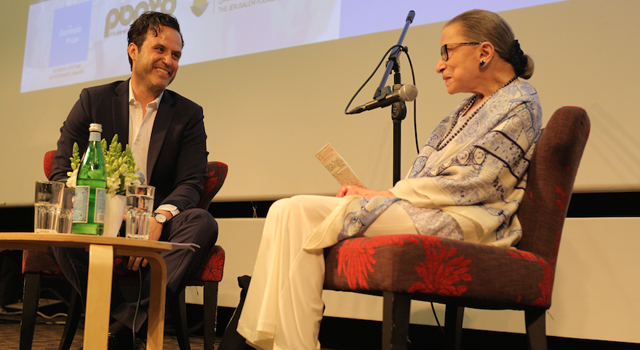 The Real/Reel Moses and Mary in Hollywood and Archaeology
The Real/Reel Moses and Mary in Hollywood and Archaeology
By Professor Richard Freund
Richard Freund is director of the Maurice Greenberg Center for Judaic Studies at the University of Hartford. He has consulted on dozens of biblical archaeology movies and has himself appeared in 17 documentaries for National Geographic, PBS, CNN, Discovery, History, NOVA and BBC films.
Last spring, he wrote about the crop of Bible movies coming out of Hollywood – including “Son of God” and “Noah” (“Hollywood Goes Biblical,” Feb. 5, 2014). Now, with several more Biblical-themed films set to open within the coming months, he continues the conversation.
Yes, this has been a banner year for Hollywood movies on religion and especially the Bible.

The Biblical prophecy of Armegeddon begins when the Rapture instantly takes all believers in Christ from the Earth. A reporter left behind learns that the Anti-Christ will soon take power.
Earlier this month, we saw Nicolas Cage starring in the Hollywood blockbuster Left Behind: The End Begins — a movie that is a part of a much larger series of books with an apocalyptic theme, which is a major part of the biblical book of Revelation in the New Testament. The recently released film, which opened nationally on Oct. 3, feeds into the entire idea that the end of the world is coming, when we read about Ebola, Enterovirus D68, MRSA infections, nuclear weapons, wars, and the machinations of the Russians. For those who have never heard of this phenomenon, “Left Behind” is a series of 12 popular books by Tim LaHaye and Jerry B. Jenkins, which have been adapted into films, and which deal with a Christian eschatological view of the end of the world.
For some unfamiliar with this theme, it certainly will be a revelation. Millions of people read the books and watched the earlier movies that began being screened in 2000. Last spring brought us “Son of God,” “Noah” and “Heaven is for Real” — all of which scored big box office numbers.
Next up is Exodus: Gods and Kings, director Ridley Scott’s take on the classic (“us versus them”) Moses story, starring Christian Bale (formerly a Batman!) as the bearded nemesis of the clean-shaven Pharaoh. It has been timed by 20th Century Fox to be released in time for the December holiday, just right for movie goers looking for religion in the cinema.
I believe this story has much to teach us about the ancient and modern period, and the story still speaks to people around the world. The fact that Hollywood studios are willing to spend hundreds of millions of dollars producing these movies says that they feel the same way. Since I teach about these characters in my courses at the University of Hartford, I have a vested interest in making these movies into a teaching moment in the classroom (all are invited to take a course in this subject. The Greenberg Center offers winter and summer term excavations in Israel; and, in the Spring 2015 semester, I will teach “World Archaeologies and Religions.”
Who was Moses?

Exodus: Gods and Kings is an upcoming biblical epic film directed by Ridley Scott. It is an interpretation of the exodus of the Hebrews from Egypt as led by Moses.
On Oct. 21, I presented a program for students, faculty and the community at the University of Hartford on Moses and Mary, in which I showed clips from the new films and discussed what we know about the characters that Hollywood has chosen to present on the screen. I started my lecture with the following question: “Tell me who is most likely to be remembered as the most famous Moses of all time?” My guess is that most people would say Charlton Heston in his 1956 Ten Commandments role. Mostly because the movie has become a television staple for the Passover-Easter season in April.
But many great actors have played Moses, including Mel Brooks, Ben Kingsley, Val Kilmer, and Burt Lancaster. And, whether we like it or not, biblical and religious education for the masses is provided by Hollywood so we who teach this in the classroom (and are often consultants for these movies) have a responsibility to take this part of popular culture and use it in the classroom to teach a variety of disciplines from language, culture, art, design, architecture, history, anthropology, religion, archaeology, geography, and cinema. Those who study these films from the “behind the scenes” research will be well-informed when they go to see the upcoming movies on Moses and Mary and understand just how historically accurate – or inaccurate – Hollywood is.
First, a disclaimer: We have absolutely no archaeological specific information on either Moses or Mary. I wish I could say we did. But really this is an expectation that archaeology can rarely match. Every once in a while, I come face to face with an ancient character, as I did in the case of Bar Kokhba’s Cave of Letters. We do not look for individual characters in archaeology (even significant ones). It would be like looking for a “needle in a haystack.”
What we do have are snippets of material culture which can inform us about the life and times of people who lived in a specific period. My favorite ancient character is Moses, since he lived in a time with so much comparative information that survived in ancient Egypt, and he figures in the Hebrew Bible, Greek literature, the New Testament, the Church Fathers, and even in the Qur’an. I see all of these texts as providing small pieces of a very large puzzle.
We even have some famous and infamous (not so ancient) descriptions and illustrations of what Moses actually looked like. In the fourth century CE (nearly 1800 years after he was no longer walking the face of the earth), a source tells us that Moses was tall and his beard was long and grey (hence the Charlton Heston Mount Sinai scene). In the Dura Europos synagogue wall painting from the third century CE, a nicely Hellenized Moses appears with a very short cropped beard and a tailored Roman style toga, but he is indeed taller than his brother Aaron, who also appears with him at the Red Sea. The ill-conceived “horned Moses” by Michelangelo that many people are familiar with was an image that haunted Jews right up until the modern period (mistranslated from Exodus 34 in which Moses’ head shone with “beams of light” as he came down Mount Sinai – not real “horns”). Moses was beloved by Jews and most everyone else in antiquity, but also reviled (Moses is the butt of a very unflattering story among the Greeks that I will not repeat here).
However, there are good archaeological pointers about the time period that Moses would have lived through in Egypt that are embedded in the texts. For example, we have beautiful small papyrus baskets discovered in ancient Egypt which were caulked with bitumen and pitch and used to send the corpses of young children down the Nile River in place of in-ground burial. When I showed students these baskets in the Cairo Museum, they could not help but connect it with the story of the baby Moses in the book of Exodus, Chapter 1. The description of the making of bricks (with and without straw) corresponds to the building work done in the Old and the New Kingdoms of lower Egypt.
But, for me, it is the small things that tell us so much about Moses the man. Consider, for example, the beard that we see in each of the movies. I have been asked by students: “Was he bearded or not?” You will see Christian Bale sporting a full beard and mustache in this version of Exodus, while his Egyptian “brother” is clean-shaven. This is probably an accurate difference between the ancient Israelites and the Egyptians, based in part on Egyptian tomb paintings that depict the actual arrival of a Semitic period with bearded men wearing those famous multi-colored robes standing in front of clean-shaven Egyptians.
Even the simplest elements about Moses are not known, however. His name, for example, never appears again in the entire Hebrew Bible. We suspect that Moses, which is a well-known Egyptian suffix that means just “son,” was used by many Pharaohs: Rameses, Tuthmoses, etc. In this movie, Exodus: Gods and Kings, Christian Bale is a more than adequate Moses, but it is all of the plagues and the miracle of the crossing of the Red Sea that will draw the crowds to this movie – these effects were unavailable to Cecile B. Demille in 1956.
Who was Mary, mother of Jesus?
Mary is a whole different question. While Moses is probably the figure of significance for the Hebrew Bible movies, in Hollywood this role is usually reserved for Jesus. Mary, mother of Jesus, is now on the verge of
becoming the fourth of the Holy Trinity, as her role in the Church has increased. Her original role in the Church has always been one that sparked great controversy.
As a researcher of first century Judaism, I have spent the better part of my career attempting to recover the historical Mary (and Jesus) from the commentaries and interpretations that have been heaped upon these uniquely human characters. It is a hard task since so many Christians have so much theological “baggage” invested in the Mary of Christianity.

“Mary, Mother of Christ” – set for release in Spring 2015-
is a prequel to Mel Gibson’s “The Passion of the Christ.”
The new film, which will be in theaters in spring 2015 — it was originally scheduled for December, but was delayed — is Mary, Mother of Christ and is a prequel to the controversial Mel Gibson 2004 movie, The Passion of the Christ. Passion, despite the controversies, remains the most successful foreign language movie of all time and the highest grossing “R” rated movie of all time. The new movie starring Odeya Rush, a 16-year-old Israeli-born actress, tries to avoid some of the problems of Passion.
Ultimately, The Passion of the Christ promoted more theological issues that were present after Jesus’ death than presenting the historical issues of Jesus’ lifetime. Mary — both Mother Mary and Mary Magdalene — has been a favorite of movie makers for the past 100 years. Most of the time Mother Mary is portrayed as a subordinate character to Jesus’ central role but now she has been moved front and center to a leading role.
In our excavations of the Church of the Annunciation (Greek Orthodox) in Nazareth (where according to Christian sources Mary met the Angel Gabriel and had the miraculous birth “announced” to her), at Mary’s Well and Bathhouse, and now at our new project at Mary’s Cave, we have sought to understand what we can know about her life in Nazareth in the first century CE. The answer is we know a lot about the city now. Pottery, glass, coins, and architecture tell us about a place where there was ample water, a good climate for farming, and a culture of mixed Jewish and Roman populations.
 When I see Mary with her “habit-like” head covering in the upcoming movie, I am reminded just how ancient customs for women are portrayed and why. The idea of “veiled Jewish women” is probably not as accurate as we have been led by medieval and modern Hollywood presentations, but it connects Mary to the nuns from the medieval church to the present. We actually have illustrations of first century Jewish women and they rarely are covered the way we see Mary portrayed in film.
When I see Mary with her “habit-like” head covering in the upcoming movie, I am reminded just how ancient customs for women are portrayed and why. The idea of “veiled Jewish women” is probably not as accurate as we have been led by medieval and modern Hollywood presentations, but it connects Mary to the nuns from the medieval church to the present. We actually have illustrations of first century Jewish women and they rarely are covered the way we see Mary portrayed in film.
But then, Hollywood is all too aware of the expectations of the viewers and the myriad images that are found of these biblical figures in medieval paintings and murals. Reality rarely trumps the imagined “reel” views.
To learn more about Moses and Mary, read Dr. Richard Freund’s book Digging through the Bible: Understanding Biblical People, Places and Controversies through Archaeology (Rowman & Littlefield, 2009).








 Southern New England Jewish Ledger
Southern New England Jewish Ledger










